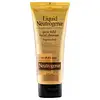What's inside
What's inside
 Key Ingredients
Key Ingredients

 Benefits
Benefits

 Concerns
Concerns

 Ingredients Side-by-side
Ingredients Side-by-side

Water
Skin ConditioningSodium Laureth Sulfate
CleansingGlycerin
HumectantPEG-7 Glyceryl Cocoate
EmulsifyingCocamidopropyl Betaine
CleansingSodium Lactate
BufferingPhenoxyethanol
PreservativePanthenol
Skin ConditioningPEG-120 Methyl Glucose Dioleate
EmulsifyingChlorphenesin
AntimicrobialLactic Acid
BufferingParfum
MaskingDisodium EDTA
Chamomilla Recutita Flower Water
MaskingSodium Hydroxide
BufferingBHT
AntioxidantPEG-40 Hydrogenated Castor Oil
EmulsifyingTrideceth-9
EmulsifyingCI 19140
Cosmetic ColorantDecylene Glycol
Skin ConditioningCI 16035
Cosmetic Colorant1,2-Hexanediol
Skin ConditioningWater, Sodium Laureth Sulfate, Glycerin, PEG-7 Glyceryl Cocoate, Cocamidopropyl Betaine, Sodium Lactate, Phenoxyethanol, Panthenol, PEG-120 Methyl Glucose Dioleate, Chlorphenesin, Lactic Acid, Parfum, Disodium EDTA, Chamomilla Recutita Flower Water, Sodium Hydroxide, BHT, PEG-40 Hydrogenated Castor Oil, Trideceth-9, CI 19140, Decylene Glycol, CI 16035, 1,2-Hexanediol
Water
Skin ConditioningGlycerin
HumectantOleic Acid
EmollientCoconut Acid
CleansingSodium Hydroxide
BufferingTriethanolamine
BufferingSodium Trideceth Sulfate
CleansingCocamidopropyl Betaine
CleansingSodium Chloride
MaskingDisodium Cocoamphodiacetate
CleansingSodium Cocoamphoacetate
CleansingCitric Acid
BufferingCaprylyl Glycol
EmollientTrisodium Hedta
Phenoxyethanol
PreservativeBHT
AntioxidantHexylene Glycol
EmulsifyingCI 19140
Cosmetic ColorantCI 17200
Cosmetic ColorantCI 42090
Cosmetic ColorantWater, Glycerin, Oleic Acid, Coconut Acid, Sodium Hydroxide, Triethanolamine, Sodium Trideceth Sulfate, Cocamidopropyl Betaine, Sodium Chloride, Disodium Cocoamphodiacetate, Sodium Cocoamphoacetate, Citric Acid, Caprylyl Glycol, Trisodium Hedta, Phenoxyethanol, BHT, Hexylene Glycol, CI 19140, CI 17200, CI 42090
 Reviews
Reviews

Ingredients Explained
These ingredients are found in both products.
Ingredients higher up in an ingredient list are typically present in a larger amount.
BHT is a synthetic antioxidant and preservative.
As an antioxidant, it helps your body fight off free-radicals. Free-radicals are molecules that may damage your skin cells.
As a preservative, it is used to stabilize products and prevent them from degrading. Specifically, BHT prevents degradation from oxidation.
The concerns related to BHT come from oral studies; this ingredient is currently allowed for use by both the FDA and EU.
However, it was recently restricted for use in the UK as of April 2024.
Learn more about BHTCI 19140 is also known as Tartrazine. Tartrazine is a synthetic dye used in cosmetics, foods, and medicine to add a yellow color.
Tartrazine is created from petroleum and is water-soluble.
Some people may experience allergies from this dye, especially asthmatics and those with an aspirin intolerance.
Learn more about CI 19140Cocamidopropyl Betaine is a fatty acid created by mixing similar compounds in coconut oil and dimethylaminopropylamine, a compound with two amino groups.
This ingredient is a surfactant and cleanser. It helps gather the dirt, pollutants, and other impurities in your skin to be washed away. It also helps thicken a product and make the texture more creamy.
Being created from coconut oil means Cocamidopropyl Betaine is hydrating for the skin.
While Cocamidopropyl Betaine was believed to be an allergen, a study from 2012 disproved this. It found two compounds in unpure Cocamidopropyl Betaine to be the irritants: aminoamide and 3-dimethylaminopropylamine. High-grade and pure Cocamidopropyl Betaine did not induce allergic reactions during this study.
Learn more about Cocamidopropyl BetaineGlycerin is already naturally found in your skin. It helps moisturize and protect your skin.
A study from 2016 found glycerin to be more effective as a humectant than AHAs and hyaluronic acid.
As a humectant, it helps the skin stay hydrated by pulling moisture to your skin. The low molecular weight of glycerin allows it to pull moisture into the deeper layers of your skin.
Hydrated skin improves your skin barrier; Your skin barrier helps protect against irritants and bacteria.
Glycerin has also been found to have antimicrobial and antiviral properties. Due to these properties, glycerin is often used in wound and burn treatments.
In cosmetics, glycerin is usually derived from plants such as soybean or palm. However, it can also be sourced from animals, such as tallow or animal fat.
This ingredient is organic, colorless, odorless, and non-toxic.
Glycerin is the name for this ingredient in American English. British English uses Glycerol/Glycerine.
Learn more about GlycerinPhenoxyethanol is a preservative that has germicide, antimicrobial, and aromatic properties. Studies show that phenoxyethanol can prevent microbial growth. By itself, it has a scent that is similar to that of a rose.
It's often used in formulations along with Caprylyl Glycol to preserve the shelf life of products.
Sodium Hydroxide is also known as lye or caustic soda. It is used to adjust the pH of products; many ingredients require a specific pH to be effective.
In small amounts, sodium hydroxide is considered safe to use. However, large amounts may cause chemical burns due to its high alkaline.
Your skin has a natural pH and acid mantle. This acid mantle helps prevent harmful bacteria from breaking through. The acid mantle also helps keep your skin hydrated.
"Alkaline" refers to a high pH level. A low pH level would be considered acidic.
Learn more about Sodium HydroxideWater. It's the most common cosmetic ingredient of all. You'll usually see it at the top of ingredient lists, meaning that it makes up the largest part of the product.
So why is it so popular? Water most often acts as a solvent - this means that it helps dissolve other ingredients into the formulation.
You'll also recognize water as that liquid we all need to stay alive. If you see this, drink a glass of water. Stay hydrated!
Learn more about Water